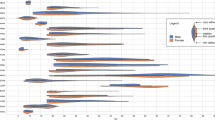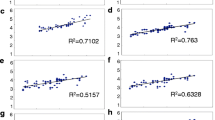Abstract
The error-related negativity (ERN) is a negative deflection in the event-related potential following a mistake that is a putative biomarker of anxiety. The study assessed the ERN as a diagnostic biomarker using receiver operating characteristic (ROC) analyses in 96 cases with anxiety disorders (AD) and 96 matched healthy controls (HC) ages 8 to 18 years. Forty-one cases had generalized anxiety disorder (GAD); 55 cases had other anxiety disorders (OAD) without GAD. ERN amplitude was significantly increased in AD cases compared to HC. The area under the curve (AUC) in the ROC analysis was 0.64, indicating the ERN is an inadequate diagnostic test for AD altogether. The ERN was significantly increased in cases with either GAD or OAD compared to HC. The AUC in ROC analyses with GAD and OAD was 0.75 and 0.56, respectively, suggesting the ERN provides an adequate diagnostic test for GAD but not for OAD.




Similar content being viewed by others
References
Merikangas KR, He JP, Burstein M, Swanson SA, Avenevoli S, Cui L, Benjet C, Georgiades K, Swendsen J (2010) Lifetime prevalence of mental disorders in U.S. adolescents: results from the National Comorbidity Survey Replication: Adolescent Supplement (NCS-A). J Am Acad Child Adolesc Psychiatry. 49(10):980–989
Kessler RC, Avenevoli S, Costello EJ, Georgiades K, Green JG, Gruber MJ, He JP, Koretz D, Ka McLaughlin, Petukhova M, Sampson NA, Zaslavsky AM, Merikangas KR (2012) Prevalence, persistence, and sociodemographic correlates of DSM-IV disorders in the National Comorbidity Survey Replication Adolescent Supplement. Arch Gen Psychiatry 69(4):372–380
Wagner G, Zeiler M, Waldherr K, Philipp J, Truttmann S, Dur W, Treasure JL, Karwauntz AFK (2017) Mental health problems in Austrian adolescents: a nationwide, two-stage epidemiological study applying DSM-5 criteria. Eur Child Adolesc Psychiatry 26:1483–1499
Woodward LJ, Fergusson DM (2001) Life course outcomes of young people with anxiety disorders in adolescence. J Am Acad Child Adolesc Psychiatry 40(9):1086–1093
Boden JM, Fergusson DM, Horwood LJ (2007) Anxiety disorders and suicidal behaviours in adolescence and young adulthood: findings from a longitudinal study. Psychol Med 37(3):431–440
Meyer A (2016) Developing psychiatric biomarkers: a review focusing on the error-related negativity as a biomarker for anxiety. Curr Treat Options Psych 3(4):356–364
Meyer A (2017) A biomarker of anxiety in children and adolescents: a review focusing on the error-related negativity (ERN) and anxiety across development. Dev Cogn Neurosci 27:58–68
Pine DS, Leibenluft E (2015) Biomarkers with a mechanistic focus. JAMA Psychiatry 72(7):633–634
Falkenstein M, Hohnsbein J, Hoormann J, Blanke L (1991) Effects of crossmodal divided attention on late ERP components. 2. Error processing in choice reaction tasks. Electroencephalogr Clin Neurophysiol 78(6):447–455
Gehring WJ, Goss B, Coles MGH, Meyer DE, Donchin E (1993) A neural system for error detection and compensation. Psychol Sci 4(6):385–390
Gehring WJ, Liu Y, Orr JM, Carp J (2012) The error-related negativity (ERN/Ne). In: Luck SK, Kappenman E (eds) Oxford handbook of event-related potential components. Oxford University Press, New York, pp 231–291
Meyer A, Bress JN, Proudfit GH (2014) Psychometric properties of the error-related negativity in children and adolescents. Psychophysiology 51(7):602–610
Anokhin AP, Golosheykin S, Heath AC (2008) Heritability of frontal brain function related to action monitoring. Psychophysiology 45:524–534
Tamnes CK, Walhovd KB, Torstveit M, Sells VT, Fjell AM (2013) Performance monitoring in children and adolescents: a review of developmental changes in the error-related negativity and brain maturation. Dev Cogn Neurosci 6:1–13
Holroyd CB, Coles GH (2002) The neural basis of human error processing: reinforcement learning, dopamine, and the error-related negativity. Psychol Rev 109(4):679–709
Bartholow BD, Pearson MA, Dickter CL, Sher KJ, Fabiani M, Gratton G (2005) Strategic control and medial frontal negativity: beyond errors and response conflict. Psychophysiology 42:33–42
Hajcak G, Moser JS, Yeung N, Simons RF (2005) On the ERN and the significance of errors. Psychophysiology 42(2):151–161
Weinberg A, Dieterich R, Riesel A (2015) Error-related brain activity in the age of RDoC: a review of the literature. Int J Psychophysiol 98(2):276–299
Brooker RJ, Buss KA (2014) Toddler fearfulness is linked to individual differences in error-related negativity during preschool. Dev Neuropsychol 39(1):1–8
Meyer A, Weinberg A, Klein DN, Hajcak G (2012) The development of the error-related negativity (ERN) and its relationship with anxiety: evidence from 8 to 13 year-olds. Dev Cogn Neurosci 2(1):152–161
Hajcak G, McDonald N, Simons RF (2003) Anxiety and error-related brain activity. Biol Psychol 64(1–2):77–90
Agam Y, Hamlainen MS, Lee AKC, Dyckman KA, Friedman JS, Isom M, Makris N, Manoach DS (2011) Multimodal neuroimaging dissociate hemodynamic and electrophysiology correlates of error processing. Proc Natl Acad Sci 108:17556–17561
Buzzell GA, Richards JE, White LK, Barker TV, Pine DS, Fox NA (2017) Development of the error-monitoring system from ages 9–35: unique insight provided by MRI-constrained source localization of EEG. NeuroImage 157:13–26
Luu P, Tucker DM, Makeig S (2004) Frontal midline theta and the error-related negativity; neurophysiological mechanisms of action regulation. Clin Neurophysiol 115:1821–1835
Trujillo LT, Allen JJB (2007) Theta EEG dynamics of the error-related negativity. Clin Neurophysiology 118:645–668
Cavanagh JF, Frank MJ (2014) Frontal theta as a mechanism for cognitive control. Trends Cogn Sci 18(8):414–421
Cavanagh JF, Shackman AJ (2015) Frontal midline theta reflects anxiety and cognitive control: meta-analytic evidence. J Physiol Paris 109(1–3):3–15
Moser J, Moran T, Schroder H, Donnellan B, Yeung N (2013) On the relationship between anxiety and error monitoring: a meta-analysis and conceptual framework. Front Hum Neurosci 7:466
Moser JS (2017) The nature of the relationship between anxiety and the error-related negativity across development. Curr Behav Neurosci Rep 4(4):309–321
Ladouceur CD, Dahl RE, Birmaher B, Axelson DA, Ryan ND (2006) Increased error-related negativity (ERN) in childhood anxiety disorders: ERP and source localization. J Child Psychol Psychiatry 47(10):1073–1082
Carrasco M, Hong C, Nienhuis JK, Harbin SM, Fitzgerald KD, Gehring WJ, Hanna GL (2013) Increased error-related brain activity in youth with obsessive-compulsive disorder and other anxiety disorders. Neurosci Lett 541:214–218
Meyer A, Hajcak G, Torpey DC, Kujawa A, Kim J, Bufferd S, Carlson G, Klein DN (2013) Increased error-related brain activity in six-year-old children with clinical anxiety. J Abnorm Child Psychol 41(8):1257–1266
Meyer A, Hajcak G, Glenn CR, Kujawa AJ, Klein DN (2017) Error-related brain activity is related to aversive potentiation of the startle response in children, but only the ERN is associated with anxiety disorders. Emotion 17(3):487
Kujawa A, Weinberg A, Bunford N, Fitzgerald KD, Hanna GL, Monk CS, Kennedy AE, Klumpp H, Hajcak G, Phan KL (2016) Error-related brain activity in youth and young adults before and after treatment for generalized or social anxiety disorder. Prog Neuro-Psychopharmacol Biol Psychiatry 71:162–168
Ladouceur CD, Tan PZ, Sharma V, Bylsma LM, Silk JS, Siegle GJ, Forbes EE, McMakin DL, Dahl RE, Kendall PC, Mannarino A, Ryan ND (2018) Error-related brain activity in pediatric anxiety disorders remains elevated following individual therapy: a randomized clinical trial. J Child Psychol Psychiatry 59(11):1152–1161
McDermott JM, Perez-Edgar K, Henderson HA, Chronis-Tuscano A, Pine DS, Fox NA (2009) A history of childhood behavioral inhibition and enhanced response monitoring in adolescence are linked to clinical anxiety. Biol Psychiatry 65(5):445–448
Meyer A, Hajcak G, Torpey-Newman DC, Kujawa A, Klein DN (2015) Enhanced error-related brain activity in children predicts the onset of anxiety disorders between the ages of 6 and 9. J Abnorm Child Psychol 124(2):266–274
Meyer A, Nelson B, Perlman G, Klein DN, Kotov R (2018) A neural biomarker, the error-related negativity, predicts the first onset of generalized anxiety disorder in a large sample of adolescent females. J Child Psychol Psychiatry 59(11):1162–1170
Gullone E (2000) The development of normal fear: a century of research. Clin Psychol Rev 20:429–451
Hajcak G, Meyer A, Kotov R (2017) Psychometrics and the neuroscience of individual differences: internal consistency limits between-subjects effects. J Abnorm Psychol 126(6):823
Hosmer DW, Lemeshow S (2000) Applied logistic regression. Wiley, New York, NY
American Psychiatric Association (2013) Diagnostic and statistical manual of mental disorders, 5th edn. American Psychiatric Association, Arlington
Kaufman J, Birmaher B, Brent D, Rao U, Flynn C, Moreci P, Williamson D, Ryan N (1997) Schedule for affective disorders and schizophrenia for school-age children-present and lifetime version (K-SADS-PL): initial reliability and validity data. J Am Acad Child Adolesc Psychiatry 36(7):980–988
Hanna GL (2013) Schedule for obsessive-compulsive and other behavioral syndromes (SOCOBS). University of Michigan, Ann Arbor
Achenbach TM, Rescorla LA (2001) Manual for ASEBA school-age forms & profiles. University of Vermont, Research Center for Children, Youth, and Families, Burlington
Eriksen BA, Eriksen CW (1974) Effects of noise letters upon the identification of a target letter in a non-search task. Percept Psychophys 16(1):143–149
Hanna GL, Liu Y, Isaacs YE, Ayoub AM, Brosius A, Salander Z, Arnold PD, Gehring WJ (2018) Error-related brain activity in adolescents with obsessive-compulsive disorder and major depressive disorder. Depress Anxiety 35(8):752–760
Gratton G, Coles MGH, Donchin E (1983) A new method for offline removal of ocular artifact. Electroencephalogr Clin Neurophysiol 55(4):468–484
Meyer A, Lerner MD, De Los RA, Laird RD, Hajcak G (2017) Considering ERP difference scores as individual difference measures: issues with subtraction and alternative approaches. Psychophysiology 54(1):114–122
Cohen J (1992) A power primer. Psychol Bull 112(1):155–159
Youden WJ (1950) Index for rating diagnostic tests. Cancer 3(1):32–35
Perkins NJ, Schisterman EF (2006) The inconsistency of “optimal” cutpoints obtained using two criteria based on the receiver operating characteristic curve. Am J Epidemiol 163(7):670–675
Hanna GL, Liu Y, Isaacs YE, Ayoub AM, Torres JJ, O'Hara NB, Gehring WJ (2016) Withdrawn/depressed behaviors and error-related brain activity in youth with obsessive-compulsive disorder. J Am Acad Child Adolesc Psychiatry 55(10):906–913
Patriquin MA, Mathew SJ (2017) The neurobiological mechanisms of generalized anxiety disorder and chronic stress. Chronic Stress 1:1–10
Carrasco M, Harbin SM, Nienhuis JK, Fitzgerald KD, Gehring WJ, Hanna GL (2013) Increased error-related brain activity in youth with obsessive-compulsive disorder and unaffected siblings. Depress Anxiety 30(1):39–46
Patrick CJ, Hajcak G (2016) RDoC: translating promise into progress. Psychophysiology 53(3):415–424
Cavanagh JF, Meyer A, Hajcak G (2017) Error-specific cognitive control alterations in generalized anxiety disorder. Biol Psychiatry Cogn Neurosci Neuroimaging 2(5):413–420
Canen MJ, Brooker RJ (2017) ERN, theta power, and risk for anxiety problems in preschoolers. Biol Psychol 123:103–110
Weinberg A, Klein DN, Hajcak G (2012) Increased error-related brain activity distinguishes generalized anxiety disorder with and without comorbid major depressive disorder. J Abnorm Psychol 121(4):885–896
Weinberg A, Kotov R, Proudfit GH (2015) Neural indicators of error processing in generalized anxiety disorder, obsessive-compulsive disorder, and major depressive disorder. J Abnorm Psychol 124(1):172–185
Acknowledgements
This study was funded by the National Institute of Mental Health of the National Institutes of Health Grant R01MH101493.
Author information
Authors and Affiliations
Corresponding author
Additional information
Publisher's Note
Springer Nature remains neutral with regard to jurisdictional claims in published maps and institutional affiliations.
Rights and permissions
About this article
Cite this article
Hanna, G.L., Liu, Y., Rough, H.E. et al. A Diagnostic Biomarker for Pediatric Generalized Anxiety Disorder Using the Error-Related Negativity. Child Psychiatry Hum Dev 51, 827–838 (2020). https://doi.org/10.1007/s10578-020-01021-5
Published:
Issue Date:
DOI: https://doi.org/10.1007/s10578-020-01021-5




